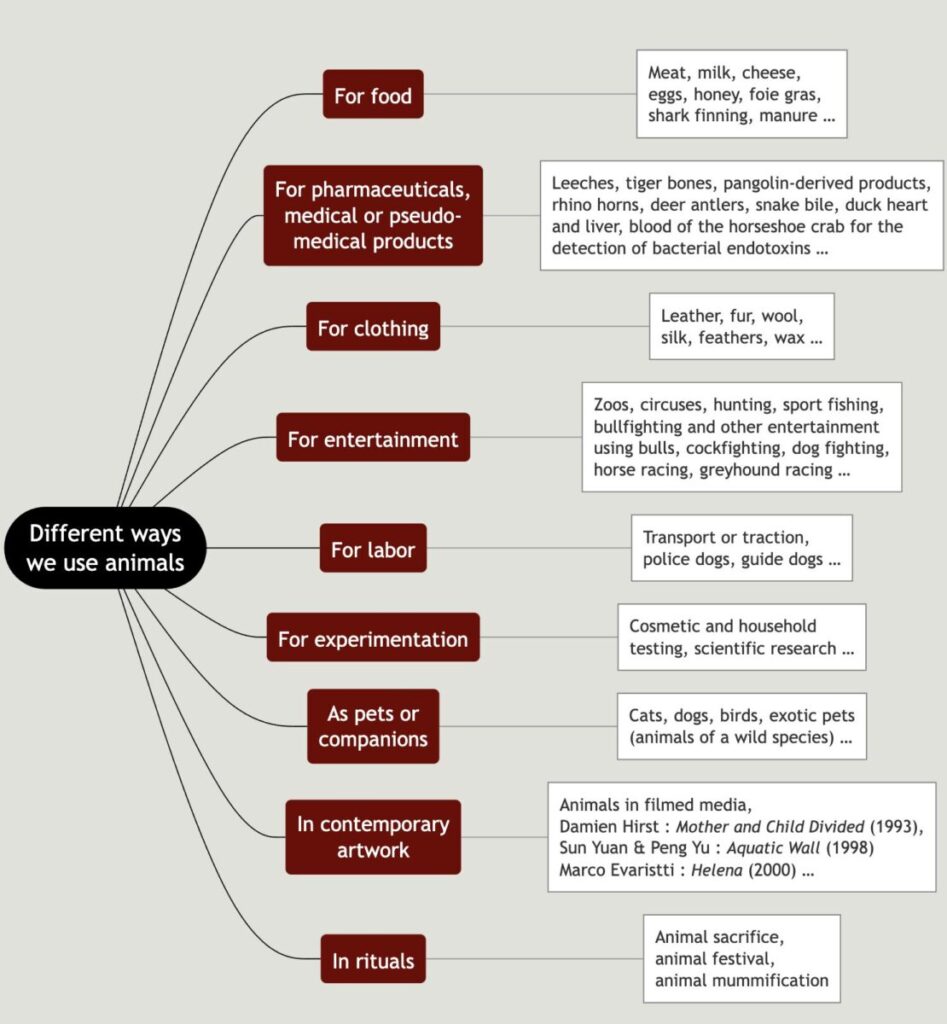La philosophie peut être enseignée en section européenne (plus d’informations ici). Voici un exemple de séquence sur l’éthique animale en DNL Anglais.
Introduction aux enjeux
1/ Travail en groupe
Consigne : “Create a mindmap : What are the different ways we use animals?”

2/ Appropriation individuelle
Very Short Essay (150 words) : In my opinion, the main problem in animal ethics is …
I – Les animaux ont-ils un esprit ?
1/ Travail introductif sur un texte et construction d’un tableau pour représenter l’évolution dans la représentation des animaux.
How We See Animals Differently Today
« Historically, animals were often regarded as mere objects or things, with little to no recognition of their intrinsic value or capacity for suffering. One of the most influential views that reinforced this perception came from the 17th-century French philosopher René Descartes. Descartes famously argued that animals were « automata, » or biological machines, devoid of consciousness, emotions, or a soul. According to his theory, animals could perform complex actions, but these were purely mechanical responses to external stimuli. They were seen as living machines, driven by instinct and devoid of the rational thought that, for Descartes, distinguished humans from other creatures. This perspective led to a justification for the use of animals in experiments and harsh treatment, as their pain or suffering was considered inconsequential – mere physical reactions, not experiences of conscious beings.
However, this view of animals has gradually evolved over time. Scientific advances, particularly in fields like biology, ethology, and neuroscience, have demonstrated that many animals are far more complex than Descartes could have imagined. Research has shown that animals possess varying degrees of intelligence, emotional capacities, and even social behaviors that closely resemble human traits. Philosophical and ethical discussions have also begun to challenge the Cartesian notion of animals as mere objects. Today, many people recognize animals as sentient beings capable of suffering, deserving of moral consideration and protection. As our understanding of the natural world deepens, the outdated view of animals as machines is being replaced by a more compassionate and informed perspective, where animals are seen as beings with intrinsic value and rights. »
2/ Sensations et émotions chez les animaux
Travail sur une vidéo
- What are the two concepts of harm?
- Why is it difficult to prove the existence of animal pain?
3/ Conscience et intelligence chez les animaux
Travail sur une vidéo
- According to Aristotle and Descartes, what is the difference between animals and human beings?
- Darwin’s theory of evolution challenged the traditional conception of animals and human beings. Explain.
- Recent experiments show that animals can solve complex problems. Illustrate.
- What is “the hard problem”?
II – Éthique normative : les grandes théories en éthique animale
1/ La critique de l’anthropocentrisme, de l’exceptionnalisme, du spécisme
Travail sur un texte :
« Anthropocentrism is an ethical framework that positions humans at the center of moral consideration, asserting that human beings hold a superior moral status compared to non-human entities. This perspective emphasizes human interests, rights, and welfare as primary concerns in ethical decision-making, often justifying the exploitation of natural resources and non-human animals for human benefit.
The justification for this anthropocentric view can be rooted in exceptionalism, which argues that humans possess unique qualities that set them apart from all other species, such as advanced cognitive abilities, emotional depth, and moral reasoning. This uniqueness is seen as the basis for a moral hierarchy where humans occupy the top position.
From the perspective of critics, both anthropocentrism and exceptionalism are considered forms of speciesism. The term speciesism was coined in the 1970s by British psychologist Richard Ryder, and it refers to the unequal treatment of beings based solely on their species membership. Just as racism is an arbitrary discrimination based on race and sexism is an arbitrary discrimination based on gender, speciesism is an arbitrary discrimination based solely on the classification within a specific biological category. »
2/ Trois théories éthiques : éthiques du care, conséquentialisme, déontologie
Document : minisite web sur ces trois théories
Consigne : par groupe, construire une carte mentale sur l’une de ces théories ; puis partager en collectif le travail de chaque groupe.
III – Éthique appliquée
1/ La consommation de viande
Repérage des arguments et objections sur ce sujet.
Construction d’un dialogue entre un vegan et un mangeur de viande.
2/ L’expérimentation sur les animaux
Quelques cas d’expérimentations sur des animaux : test de Draize, DL50.
Travail par groupe : choix d’une situation concrète et positionnement sur le sujet.
Travail sur la règle des 3R.
